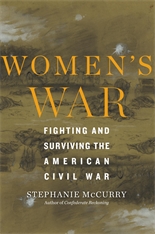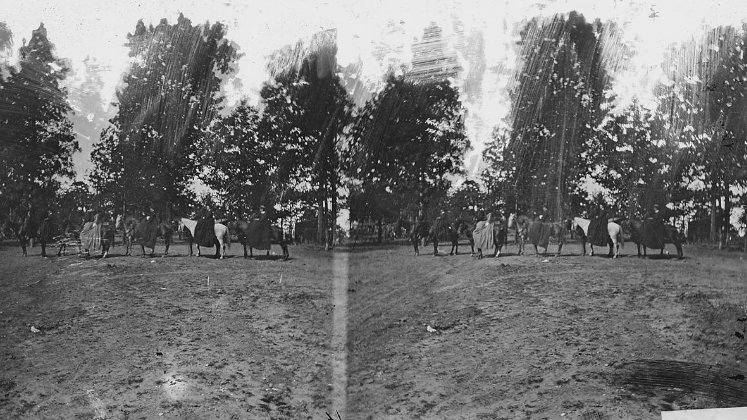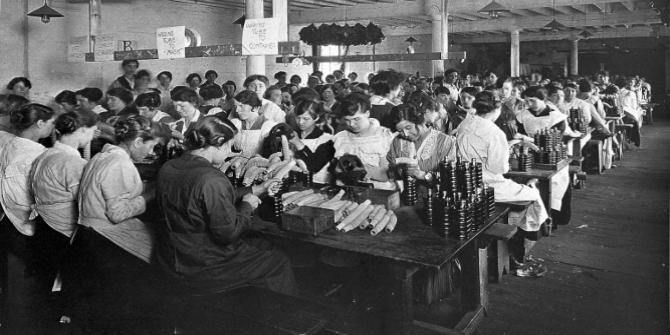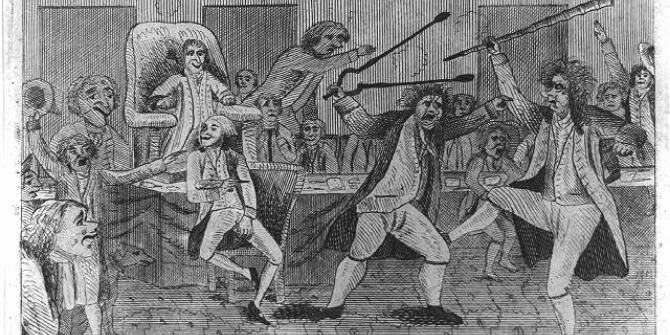In Women’s War: Fighting and Surviving the American Civil War, Stephanie McCurry challenges the tendency to position women outside of histories of conflict, examining the roles played by different groups of women during the US Civil War and its aftermath. The study collapses the gendered separation of war and women by positioning women as an integral part of military history, writes Ben Margulies, and it expands the scope of the political in ways that inform our understanding of today as much as they do our knowledge of the US Civil War.
Women’s War: Fighting and Surviving the American Civil War. Stephanie McCurry. Harvard UP. 2019.
 Women’s Wars and Wars Over Women
Women’s Wars and Wars Over Women
Recently, a fragment of the COVID-19 culture wars caught the attention of Twitter. R.R. Reno, editor of the US religious journal First Things, wrote: ‘By the way, the WWII vets did not wear masks. They’re men, not cowards. Masks = enforced cowardice.’ The analogy falls somewhere between feeble and failed, but it is revealing. (It is also deleted, which doesn’t strike me as a profile in courage – but I digress. Reno apologised for his comments here.)
Note that Reno equated World War II veterans with ‘men’. The assumption is that in general only men fight, and specifically that only men fought in World War II. As Stephanie McCurry writes in her excellent book, Women’s War: Fighting and Surviving the American Civil War, women have been combatants in most human conflicts. Addressing World War II in the epilogue, McCurry notes that ‘somewhere between 800,000 and 1 million women fought in the Soviet Army’ during World War II, ‘and many more in partisan forces’ (211). McCurry’s aim, in part, is to address the sort of wilful neglect of women’s military participation that we see in Reno’s misconceived tweet.
McCurry’s recent research focuses on the US Civil War, and more specifically on how certain ‘subaltern’ groups are, in fact, central to its history. In her last book, Confederate Reckoning, she discussed how women and enslaved people were central to the Confederacy’s politics and survival, even though the Confederate political order denied them the status of citizens.
One of the primary goals of Women’s War is to excavate the history of women in war, and specifically women’s agency in the US Civil War. McCurry writes that historians, and society more generally, try their best to ignore women’s participation in war, both during and especially after wars have concluded: ‘The fact that women are perpetrators and active participants in war is a disturbing truth acknowledged only reluctantly and under duress in the midst of conflicts’ (13-14). Legal theory in the nineteenth century treated the category of ‘woman’ as nearly synonymous with ‘non-combatant’.
McCurry’s book demonstrates how artificial and unfounded this distinction is. She reveals the dense intertwining of women and the making of war, revealing their activities as spies, couriers, activists and conquered foes. She also attacks the distinction between military and social affairs, and between ‘public’ and ‘private’ or ‘family’ life:
Women’s accounts of military conflicts are not easily confined to the battlefield, the war room or the treaty table but range onto unfamiliar ground. Their views necessarily include the impact of war, social collapse and postwar reconstruction in personal as well as military and political realms. Women pull into the record allegedly ‘private’ but highly consequential matters of marriage and the family, revealing the way war disorders even these fundamental relations of social and political life (10)

McCurry’s work focuses on three key episodes in the US Civil War. The first relates directly to women – in this case, white women – as combatants. She gives an account of the evolution of US military law during the Civil War, as the Union Army confronted irregular warfare in the border states and the Upper South. The existing laws of war did not cover what to do with non-combatants who were also disloyal citizens, and jurist Francis Lieber set to work on a new code of military law and new definitions of treason. In doing so, he had to confront – as the Union Army had to confront – the existence of women combatants. McCurry reveals how the Union Army’s general-in-chief, Henry Halleck, introduced the idea of women’s legal liability for treason, in response to the many women serving as spies, saboteurs, couriers and auxiliaries for the Confederate forces.
The second part of the book focuses on enslaved women and their struggle for liberty. Here, McCurry recounts the history of military emancipation, which was predicated on a) depriving the Confederacy of African American enslaved labour; and b) from 1862, encouraging African American men to join the Union forces. This story was capably told by James Oakes in Freedom National, but McCurry opens up a new angle by examining the plight of enslaved women. Their liberation could not be justified by military necessity, so it was unclear what legal right the Union had to deny slaveholders’ ‘property rights’.
The solution was to make the women ‘soldiers’ wives’, using marriage as an administrative category to justify emancipating the dependents of Union soldiers. From the perspective of the Union forces, this had the added benefit of disciplining African Americans to white bourgeois social norms – enslaved people had been unable to legally marry or maintain families, and McCurry describes federal officials trying to counter free people’s ‘false ideas about chastity’ and instil ‘the obligations of the married state in civilized life’ (94). This presumption about marital status applied even when the women clearly came into Union lines without any men accompanying them and ignored that many enslaved women had been active in plantation rebellions themselves.
The final part of the book centres on the role of women in the South’s dominant class, the white planter elite. Here, McCurry uses the diaries of one woman, Gertrude Clanton Thomas of Georgia, to examine how women adjusted to the defeat and decline of their class. Thomas watched as war and a particularly feckless husband drove her family into destitution, increasingly aware but largely disempowered by law and habit.
What McCurry does very well – and this was also a signal feature in Confederate Reckoning – is to draw out how structures of slavery and patriarchal marriage ran in parallel to one another. McCurry argues that these largely limited the political world to white men, while subjecting everyone else to the private rules and individual caprice of those same white men. The enslaved became their property, while white married women became their husbands’ wards, with limited control over their assets, which could include enslaved people before the Civil War. ‘Women had […] a secondhand relationship to the state’ (24); though they played a role in the private government of white households and enslaved people, white Southern women had little real control over their property. Though Stephanie E. Jones-Rogers argues that married women in the South had significant property rights during slavery in They Were Her Property (‘the doctrine of coverture was a legal fiction, and an imperfect one at that’ (28)), it is fair to say that married women’s legal and social control over their assets was inferior to that of their husbands.
This lack of legal and economic autonomy continued after the war. McCurry observes that even as emancipation destroyed one form of private white government, it extended patriarchy in the family: ‘An act as radical as emancipation was unthinkable without that anchoring order, yoking men to the responsibilities of husbands, and subjecting women to the authority of particular men’ (119). She quotes ‘proslavery sociologist George Fitzhugh’, who said ‘Marriage is too much like slavery not to be involved in its fate’ (119). Even when Georgia passed a married women’s property law and a homestead exemption (from debt claims), ‘the laws themselves did not suggest that women could do anything with their property other than possess it’ (179).
McCurry shows how the patriarchal family structure allowed Clanton Thomas’s husband to dispose of his wife’s property freely in the post-war period, using his informal authority as husband to compel Gertrude Clanton Thomas to surrender what property rights she possessed: McCurry observed that she in fact had ‘legal title’ to the bulk of the marital property, ‘but she was his wife, and when he asked her to sign them [her property rights] away, she could not refuse’ (187).
By broadening her scope to the political structure of the family, McCurry also contributes to ongoing debates about whether emancipation and Reconstruction represented a real departure in the workings of white supremacy and capitalism, or merely a reconfiguration of these systems. Citing Clanton Thomas’s diaries, McCurry contends that, at the level of family relations and family economies – where women did have a good deal of power – Reconstruction was a revolution. It dissolved white claims that those they enslaved were members of their ‘families’, while allowing millions of African Americans to form legal families for the first time.
Women’s War unearths a number of interesting parallels with twentieth- and twenty-first-century political debate. For example, McCurry discusses Charles Sumner’s early proposal for what became the 13th Amendment, which began ‘All persons are equal before the law…’ (120). This amendment failed precisely because it risked granting women legal equality and overturning husbands’ legal power over their wives. The epilogue recounts Elizabeth Cady Stanton giving a speech in the New York State Capitol stating that ‘Reconstruction must begin at home’ (206) – neatly anticipating ‘the personal is political’.
Women’s War is a short book, focused on certain themes, and as such, it leaves some matters unexamined. McCurry notes that one reason for making women legal minors was to make their husbands – not the government – responsible for their welfare (23). It would have been helpful to have a better understanding of nineteenth-century attitudes towards, and fears regarding, poverty and poor relief.
Another theme in McCurry’s work is the relentless white monitoring of African American sexuality and family; Union authorities worried about the morals and constancy of black ‘soldiers’ wives’, and Clanton Thomas feared liaisons between white men and African American women. McCurry doesn’t find time to connect this to the long post-Civil War history of policing the personal lives of African Americans, like the Moynihan Report published in the 1960s. She also doesn’t connect Clanton Thomas’s worries with contemporaneous racist fears regarding sexual relations between African American men and white women.
However, McCurry’s work remains immensely valuable. Women’s War forces us to confront and accept the role of women at the centre of military history, collapsing the gendered separation of war and women. Perhaps more importantly, it develops on McCurry’s earlier work, continuing her anatomy of how the United States uses a wide variety of legal and social mechanisms, public and private, to enforce inequality and privilege. She expands the scope of the political in ways that inform our understanding of today as much as they do our knowledge of the US Civil War. I highly recommend it – even to R.R. Reno.
Note: This review gives the views of the author, and not the position of the LSE Review of Books blog, or of the London School of Economics.
Image Credit: Photograph entitled ‘Staff of Gen. Sherman accompanied by ladies’, taken by Mathew Brady. Local item identifier: 111-B-1964 (US National Archives, No Known Copyright Restrictions).








2 Comments